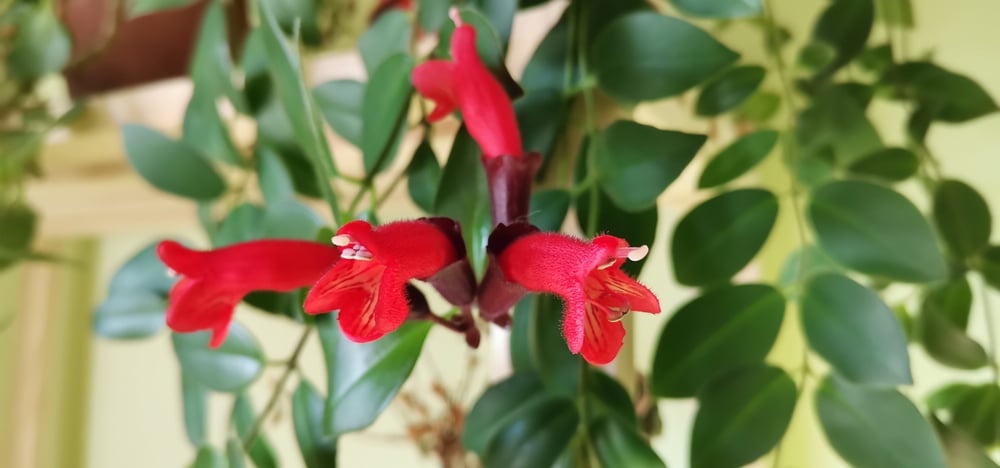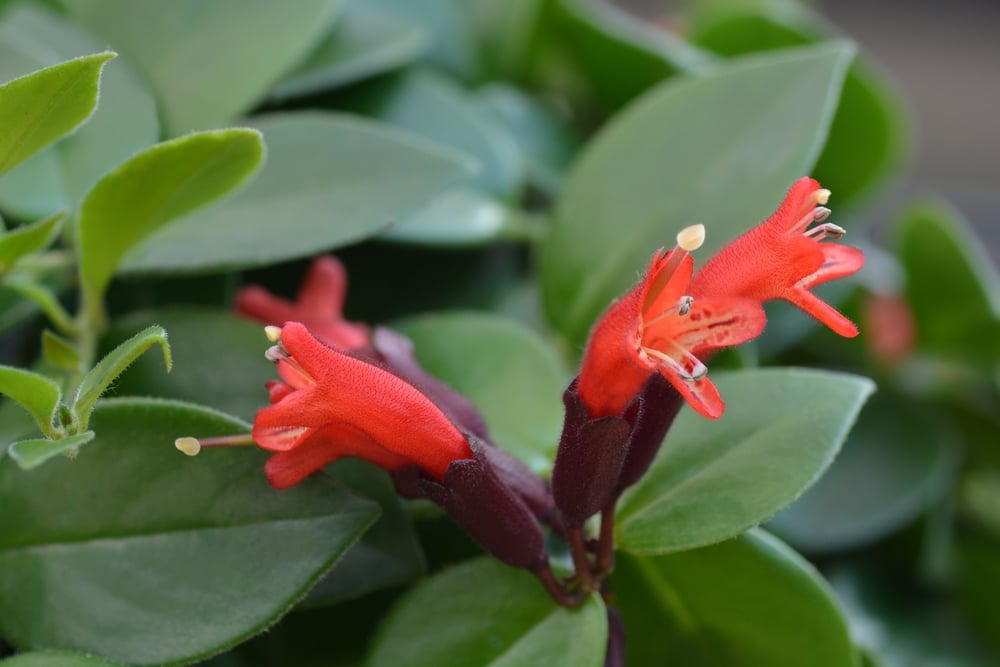The lipstick plant is a beautiful addition to any garden. Its bright red flowers and lush green leaves are sure to turn heads.
This guide will teach you everything you need to know about growing this stunning plant.
Lipstick Plant: The Origins

The lipstick plant got its name from its unique flowers, which resemble lipstick tubes. These beautiful blooms range in color from red to orange to yellow and make for a stunning addition to any garden or home. It produces blooms from June to September. It is also known as the lipstick plant, lipstick vine, and basket vine.
Native to the rainforests of Southeast Asia, the lipstick plant typically grows as an epiphyte on other trees. This means it uses other trees for support but doesn’t harm them. Vines can grow up to 3 feet in length and produce dense foliage that provides much-needed shade in hot climates.
In their native habitats, they are often used as ornamental plants. However, they can also be found in pots and hanging baskets in homes worldwide.
Lipstick Plant Varieties
Aeschynanthus is a genus of more than 185 species of flowering plants. All of these plants are native to tropical Asia and belong to the family Gesneriaceae. Some of the most popular varieties include:
Aeschynanthus japhrolepis
This vine is characterized by its trailing stems, which can reach a length of up to 4 feet, and its narrow, rich green leaves. From June to September, this species delights with salmon-pink to red-orange flowers.
Aeschynanthus marmoratus
Native to Vietnam, it is most noted for its beautiful leaves. The leaves are marbled in various shades of green on the upper side and brown-purple on the underside. The leaves grow on long stems that bear clusters of orange flowers from summer to early winter.
Aeschynanthus pulcher
There is great variation within this variety of plants, with some having curled leaves. One example is Aeschynanthus pulcher’ Twister’, which has uniquely curled leaves. This diversity is one of the things that makes the lipstick plant so popular among gardeners.
Aeschynanthus radicans
This is the most common type of lipstick plant. It has thick leaves, which are a deep green color with maroon undersides. The flowers are a deep red color and bloom from summer to fall.
Aeschynanthus speciosus
This variety is popular for hanging baskets due to its long vines and colorful flowers. The leaves of the Aeschynanthus speciosus are dark green and can grow up to 10 cm in length. The vine, however, can reach up to 60 cm. The flowers of the plant vary in color. The most popular type of Aeschynanthus speciosus is the ‘Mona Lisa,’ which has deep red blooms.
Caring For A Lipstick Plant
Lipstick plants are tropical plants, which means they thrive in warm, humid climates. If you live in a temperate climate, you can still grow lipstick plants, but you will need extra care.
Sunlight
When planting your lipstick plant, be sure to choose a spot that gets plenty of indirect sunlight. These plants do not do well in direct sunlight and will scorch easily.
Soil
One of the key things to remember when growing lipstick plants is that they need a well-aerated medium. This means that the soil should be loose and not densely packed. In addition, the soil should be evenly moist. Lipstick plants also need well-draining soil. This is important because the roots of the plant can rot if they are constantly wet. Amend your soil with perlite or sand to ensure good drainage.
Water
To keep your lipstick plant alive, give it consistent moisture, particularly during its most productive time. Root rot, leaf drop, and fungal problems can all occur due to overwatering and soggy conditions. Ideal watering is when the top few inches are still moist. It’s best to avoid allowing the potting media to go entirely dry.
Fertilizer
A slow-release fertilizer is ideal for lipstick plants. Be sure to use a fertilizer high in phosphorus to encourage blooming. Apply the fertilizer according to the package directions.
Temperature
The ideal temperature for a flourishing Lipstick Plant is between 65 and 75 degrees Fahrenheit. Temperatures below 50 degrees are poor, and the leaves will probably begin to fall.
Changes in temperature and drafts can also be harmful. As a result, it’s not ideal to place your lipstick plant next to doors or windows that allow a lot of airflow. Your lipstick plant will blossom beautifully for many years if you give it the required attention.
Humidity
Lipstick plants love humidity. If you live in a dry climate, you may need to take extra steps to provide adequate moisture for your plant. One option is to place the pot on a pebble-filled tray of water. This will help to raise the humidity around the plant. You can also mist your plant regularly with distilled water.
Is Pruning Essential?
Pruning is a vital part of maintaining a healthy lipstick plant. In its natural habitat, the lipstick plant grows as a vine, wrapping itself around trees and other tall objects. When grown indoors, however, the plant typically takes on a more bushy form.
Pruning helps to encourage new growth and prevent the plant from becoming overgrown. It also ensures that the plant continues producing abundant, vibrant flowers. While pruning may seem daunting, it is quite easy to do. Of course, if you choose to prune your plant, do so carefully.
When pruning, always cut above a leaf node. This will aid in the development of new shoots. It’s also crucial to ensure your pruning equipment’s blades are clean. Cleaning the blades of your pruning instruments with rubbing alcohol helps to avoid disease transmission.
Conclusion
Lipstick plants are beautiful, easy-to-care-for houseplants that will bring a touch of the tropics to your home. With their vibrant flowers and glossy leaves, these plants are sure to add some life to any space. Be sure to provide your lipstick plant with indirect sunlight, well-draining soil, and consistent moisture. And don’t forget to prune regularly!

